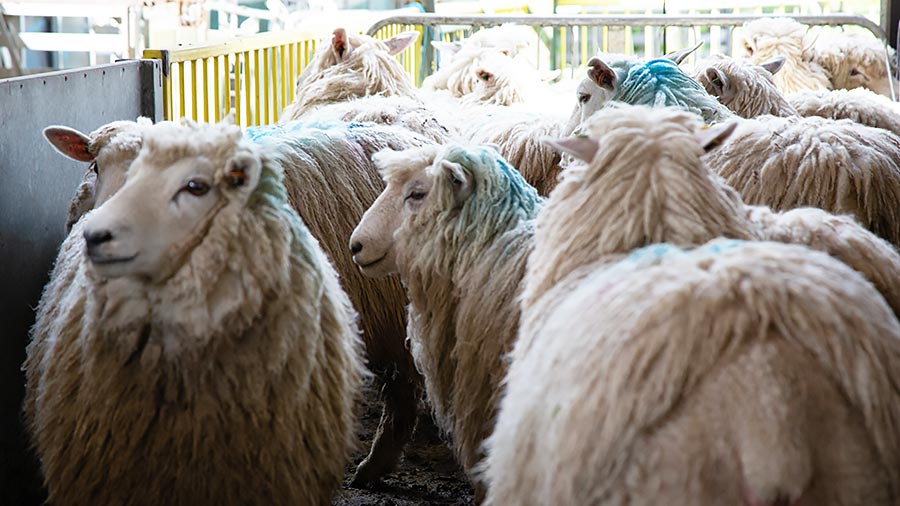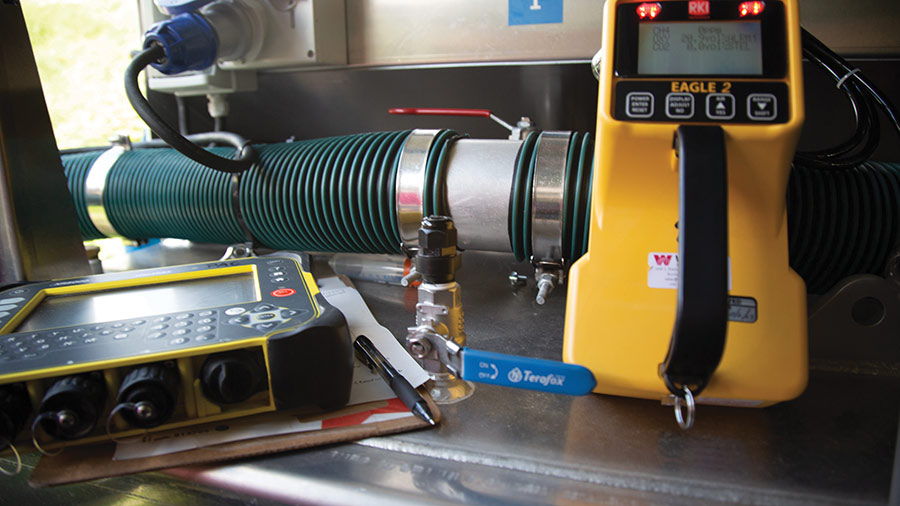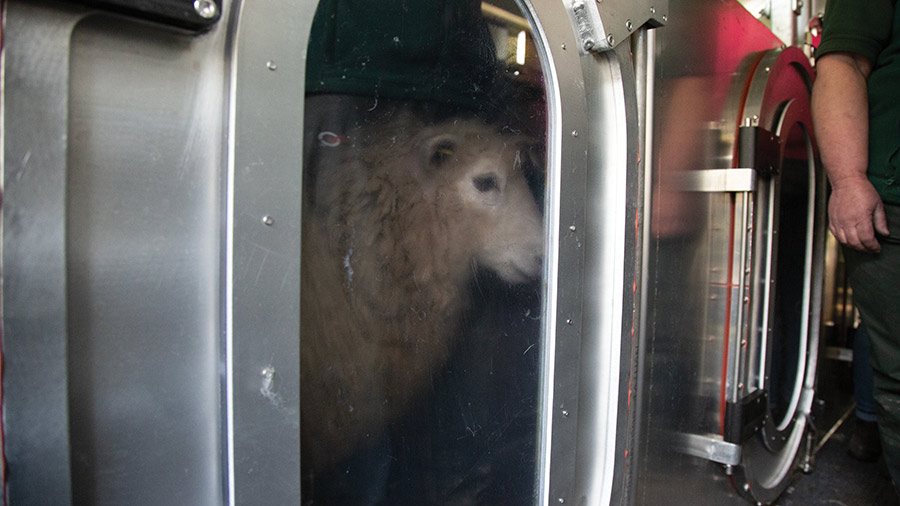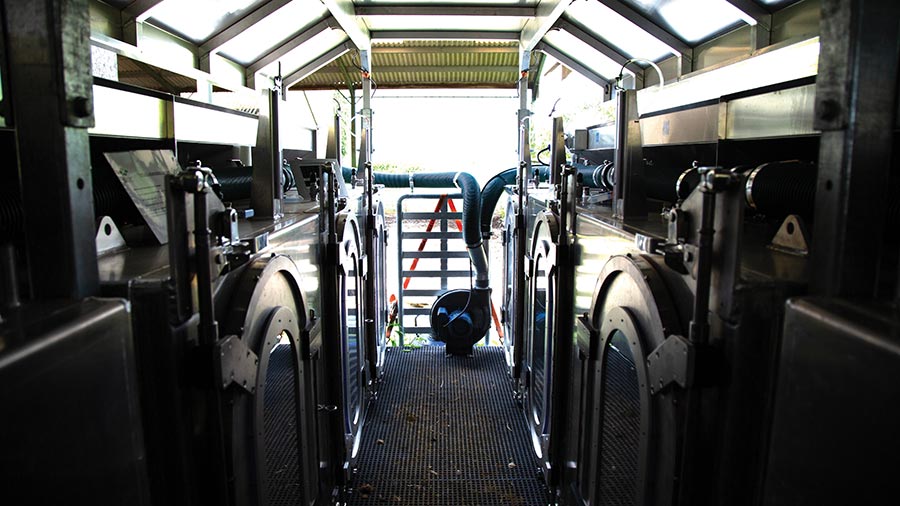Video: How a lowland farm is preparing for low-methane sheep
 © MAG/Martin Ward
© MAG/Martin Ward Results from the first UK farm to test methane emissions in sheep using portable accumulation chambers have shown they were producing on average about 20g/day of methane and 1.2kg/day of carbon dioxide.
The trial took place at Hole Farm, Hertfordshire where Rob Hodgkins and Jo Franklin run 2,500 New Zealand Romneys and sell female breeding stock for low-input sheep systems.
However, there was a large amount of variation between the 120 yearlings used in the trial.
See also: 17 ways sheep farmers can work towards net zero
Despite being managed in the same group on a grass-only diet, the sheep recorded methane emissions varying from 12g/day to 28g/day, which could not be explained solely by differences in liveweight.
“Preliminary analysis on this relatively small sample of sheep suggests there may be significant differences between sires in how much methane their offspring produce,” says Dr Nicola Lambe, a sheep geneticist with SRUC.
“This result supports research findings from New Zealand, Ireland and other countries, which have shown that methane emissions measured in portable accumulation units [PACs] are under genetic control,” says Nicola.
“Therefore, there should be scope to include these methane measurements in breeding programmes to try to simultaneously optimise production efficiency and reduce methane emissions from sheep.”
Farm facts
- 2,500 New Zealand Romneys run on 405ha (1,000 acres) of grass
- Sells female breeding stock for outdoor-lambing, low-input, forage-based systems
- Supplies lamb to Tesco
- 300-ewe sheep dairy set up in 2022
- 810ha (2,000 acres) combinable crops
Rob and Jo were awarded £48,884 from Innovate UK, which funds business-led innovation.
This was co-ordinated by Agri-EPI and covered the hire of the PACs, input from SRUC, and DNA profiling.
At Hole Farm, grazing was measured to establish dry matter intakes during the five weeks before testing.
Sheep were then weighed at testing (average 57kg; range 43-83kg) and were allocated to groups of 12 to ensure there was a mix of sires in each one.
How the testing works

The Eagle 2 gas monitor © MAG/Martin Ward
The testing equipment was designed and built by AgResearch in New Zealand.
It comprises 12 portable accumulation chambers (PACs) mounted on a trailer, six either side of a central aisle. Each chamber is a sealed metal box and can hold one sheep.
Prior to testing, each sheep’s electronic identification (EID) is recorded along with its weight, the chamber number and the gas measurements in the chamber.
Two sets of measurements are taken, two weeks apart.
The sheep enters the chamber via a door at the front and can be seen at all times during testing through a large window in the door.

A ewe in one of the measurement chambers © MAG/Martin Ward
It spends 50 minutes in the PAC; during this time, the animal is monitored visually, and the percentage of oxygen and carbon dioxide, and methane in parts/million, are measured using an Eagle 2 gas monitor via a valve in the top of each chamber.
Gas measurements are taken at 25 minutes and 50 minutes, explains SRUC senior technician John Gordon, who carried out the testing at Hole Farm with fellow senior technician Kirsty McLean.
“The 25-minute check is to make sure the level of carbon dioxide is not too high.
“If it is, we follow a protocol that might mean letting a sheep out early,” he says, adding that research has shown the level of carbon dioxide after 50 minutes is “way below” what could be considered dangerous to the animal.
After 50 minutes, the sheep are let out, the chambers are cleaned, and fresh air is run into them ready for the next batch.
Potential for low-methane sheep
At an average of 20g/day a sheep, methane emissions from Rob and Jo’s existing flock are minuscule compared with, say, large leaks from oil and gas operations. So is there any point in trying to reduce them?
“I can only do what’s in front of me: methane emissions on a farm scale,” says Rob. “But even from a purely economic point of view, it’s worth taking a punt that in 10 years there will be a market [for low-methane sheep].”
Commitments to achieve net-zero emissions made by Tesco (which he supplies with lamb), the NFU and the government have convinced him he should be looking at this issue now.
“Like it or not, this is coming up,” he says. “You can bury your head in the sand or ride the wave and maybe make some money from it.”
Genetic progress in sheep, where a full production cycle takes two years and output averages about 1.6 lambs a year, is slow, he adds. To capitalise on low-methane sheep, work needs to start on breeding them now.
Tesco pays on a cost-of-production basis and with a bonus/kg for completing a carbon audit and maintaining certain welfare standards.
Rob can see the day where the supermarket might develop a high-environment range, paying a bonus for low methane emissions and regenerative farming practices.

Inside the PAC trailer © MAG/Martin Ward
Next steps
At Hole Farm, the aim is to use the trial results as a baseline against which further testing can be measured, with a view to starting a breeding programme next year.
DNA profiling offers further potential. “Our flock shares strong genetic links to New Zealand, where a DNA profile for the New Zealand Romney has already been made,” explains Rob.
“We also run a very similar grass-based system, so as long as we continue to bring their genetics in, we can tap into their data and directly measure our progress against a country that’s been doing methane testing for 10 years.
“In theory, with those 120 methane measurements, we can test other related sheep in the field and predict their methane potential.”
He hopes to access further funding to build on the initial trial work.
At SRUC, the next steps are to collect PAC measurements of methane from other well-recorded sheep flocks in the UK across generations.
These can be used to investigate the genetic control of emissions in UK sheep, and genetic relationships with other important traits.
“This will allow methane measurements to be incorporated into breeding programmes for UK sheep in the most appropriate way,” says Nicola.
Why test sheep for methane?
There is an urgent need to mitigate greenhouse gas (GHG) emissions – specifically methane – from ruminant livestock production systems, says Scotland’s Rural College (SRUC) sheep geneticist Dr Nicola Lambe.
Globally, sheep release about 700m tonnes of methane into the atmosphere each year, according to the UN Food and Agriculture Organization’s statistics for 2020, she adds.
“Despite resource efficiency and GHG emissions being global priorities, there are few examples of research to implement breeding strategies that directly tackle these issues in sheep,” she says.
“This is largely because of the difficulty in recording feed consumption and GHG emissions on an individual-animal basis, especially in grass-based systems.”
Portable accumulation chambers (PACs) offer a solution because they can be used:
- To measure methane and other gas emissions from individual sheep rapidly
- To predict methane emissions in individual sheep from a variety of systems (including at pasture) and locations.
